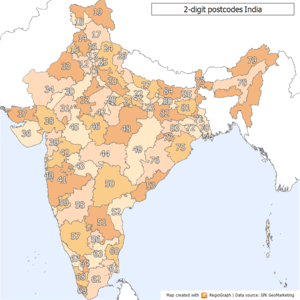Postal Index Number

A Postal Index Number or PIN or Pincode is a code in the post office numbering or 233227 system used by India Post, the Indian postal administration. The code is six digits long.
History
The PIN Code system was introduced on 15 August 1972 by Shriram Bhikaji Velankar, an additional secretary in the Union Ministry of Communications.[2][3][4] The system was introduced to simplify the manual sorting and delivery of mail by eliminating confusion over incorrect addresses, similar place names and different languages used by the public.[5]
Postal zones
There are nine PIN zones in India, including eight regional zones and one functional zone (for the Indian Army). The first digit of the PIN code indicates the region. The second digit indicates the sub-region, and the third digit indicates the sorting district within the region. The final three digits are assigned to individual post offices.
The 9 PIN zones cover the Indian states and union territories as follows:
- 1 - Delhi, Haryana, Punjab, Himachal Pradesh, Jammu and Kashmir, Chandigarh
- 2 - Uttar Pradesh, Uttarakhand
- 3 - Rajasthan, Gujarat, Daman and Diu, Dadra and Nagar Haveli
- 4 - Goa, Maharashtra, Madhya Pradesh, Chhattisgarh
- 5 - Andhra Pradesh, Karnataka, Telangana
- 6 - Tamil Nadu, Kerala, Puducherry, Lakshadweep
- 7 - Odisha, West Bengal, Arunachal Pradesh, Nagaland, Manipur, Mizoram, Tripura, Meghalaya, Andaman and Nicobar Islands, Assam, Sikkim
- 8 - Bihar, Jharkhand
- 9 - Army Post office (APO) and Field Post office (FPO)
PIN numbering
Sorting district

The first three digits of the PIN represent a specific geographical region called a sorting district that is headquartered at the main post office of the largest city and is known as the sorting office. A state may have one or more sorting districts depending on the volumes of mail handled.
| PIN prefix | Region |
|---|---|
| 11 | Delhi |
| 12 to 13 | Haryana(Kamania) |
| 14 to 15 | Punjab |
| 16 | Chandigarh |
| 17 | Himachal Pradesh |
| 18 to 19 | Jammu and Kashmir |
| 20 to 28 | Uttar Pradesh and Uttarakhand |
| 30 to 34 | Rajasthan |
| 36 to 39 | Gujarat |
| 403 | Goa |
| 40 to 44 | Maharashtra |
| 45 to 48 | Madhya Pradesh |
| 49 | Chhattisgarh |
| 50 | Telangana |
| 51 to 53 | Andhra Pradesh |
| 56 to 59 | Karnataka |
| 60 to 64 | Tamil Nadu |
| 67 to 69 | Kerala |
| 682 | Lakshadweep (Islands) |
| 70 to 74 | West Bengal |
| 744 | Andaman and Nicobar Islands |
| 75 to 76 | Odisha |
| 78 | Assam |
| 79 | Arunachal Pradesh |
| 793, 794, 783123 | Meghalaya |
| 795 | Manipur |
| 796 | Mizoram |
| 799 | Tripura |
| 80 to 85 | Bihar and Jharkhand |
Service route
The fourth digit represents the route on which a Delivery office is located in the sorting district.[5] This is 0 for offices in the core area of the sorting district.
Delivery office
The last two digits represent the delivery office within the sorting district starting from 01 which would be the GPO or HO. The numbering of the delivery office is done chronologically with higher numbers assigned to newer delivery offices. If the volume of mails handled at a delivery office is too large, a new delivery office is created and the next available PIN is assigned.[6] Thus two delivery offices situated next to each other will only have the first four digits in common.
Delivery system
Each PIN code is mapped to exactly one delivery post office which receives all the mail to be delivered to one or more lower offices within its jurisdiction, all of which share the same code. The delivery office can either be a General Post Office (GPO), a Head Office (HO) or Sub Office (SO) which are usually located in urban areas. The post from the delivery office is sorted and routed to other delivery offices for a different PIN or to one of the relevant sub offices or branch offices for the same PIN. Branch offices (BO) are located in rural areas and have limited postal services.[7]
References
- ↑ "Pincode of Ujjain - Ujjain, Madhya Pradesh". Archived from the original on October 1, 2015. Retrieved 7 May 2015.
- ↑ India. Publications Division, Ministry of Information and Broadcasting, Government of India. 1974. p. 305. Retrieved 17 May 2013.
- ↑ "Mails section". Indian government postal department. Retrieved 17 May 2013.
- ↑ "Using pincode, maps to trace address". timesofindia.com.
- 1 2 "Tamilnadu Postal Circle - Pincode". tamilnadupost.nic.in.
- ↑ http://www.icar.org.in/files/circulars/new_pin.pdf
- ↑ http://www.indiapost.gov.in/Pdf/Manuals/PO_Guide_Part-1.pdf